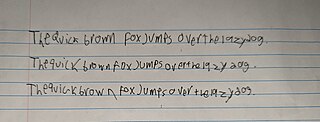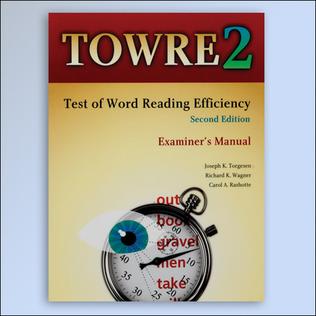Related Research Articles

Dyslexia, previously known as word blindness, is a learning disability that affects either reading or writing. Different people are affected to different degrees. Problems may include difficulties in spelling words, reading quickly, writing words, "sounding out" words in the head, pronouncing words when reading aloud and understanding what one reads. Often these difficulties are first noticed at school. The difficulties are involuntary, and people with this disorder have a normal desire to learn. People with dyslexia have higher rates of attention deficit hyperactivity disorder (ADHD), developmental language disorders, and difficulties with numbers.

Hyperlexia is a syndrome characterized by a child's precocious ability to read. It was initially identified by Norman E. Silberberg and Margaret C. Silberberg (1967), who defined it as the precocious ability to read words without prior training in learning to read, typically before the age of five. They indicated that children with hyperlexia have a significantly higher word-decoding ability than their reading comprehension levels. Children with hyperlexia also present with an intense fascination for written material at a very early age.

Dysgraphia is a neurological disorder and learning disability that concerns impairments in written expression, which affects the ability to write, primarily handwriting, but also coherence. It is a specific learning disability (SLD) as well as a transcription disability, meaning that it is a writing disorder associated with impaired handwriting, orthographic coding and finger sequencing. It often overlaps with other learning disabilities and neurodevelopmental disorders such as speech impairment, attention deficit hyperactivity disorder (ADHD) or developmental coordination disorder (DCD).
Reading for special needs has become an area of interest as the understanding of reading has improved. Teaching children with special needs how to read was not historically pursued due to perspectives of a Reading Readiness model. This model assumes that a reader must learn to read in a hierarchical manner such that one skill must be mastered before learning the next skill. This approach often led to teaching sub-skills of reading in a decontextualized manner. This style of teaching made it difficult for children to master these early skills, and as a result, did not advance to more advanced literacy instruction and often continued to receive age-inappropriate instruction.
The double-deficit theory of dyslexia proposes that a deficit in two essential skills gives rise to the lowest level of reading performances, constituting the most severe form of dyslexia.
A reading disability is a condition in which a person displays difficulty reading. Examples of reading disabilities include: developmental dyslexia, And alexia,
The Geschwind–Galaburda hypothesis is a neurological theory proposed by Norman Geschwind and Albert Galaburda in 1987. The hypothesis posits there are sex differences in cognitive abilities by relating them to lateralisation of brain function. The maturation rates of cerebral hemispheres differ and are mediated by circuiting testosterone levels, which are substantially influenced during the foetal and post-puberty development stages.
The phonological deficit hypothesis is a prevalent cognitive-level explanation for the cause of reading difficulties and dyslexia. It stems from evidence that individuals with dyslexia tend to do poorly on tests which measure their ability to decode nonsense words using conventional phonetic rules, and that there is a high correlation between difficulties in connecting the sounds of language to letters and reading delays or failure in children.

Management of dyslexia depends on a multitude of variables; there is no one specific strategy or set of strategies that will work for all who have dyslexia.
The Center for Research, Evaluation and Awareness of Dyslexia is a university-based program at Pittsburg State University in Pittsburg, Kansas, United States. It was established in 1996 to develop strategies for the prevention and remediation of reading disabilities, search for strategies that will lead to the improvement of remedial processes, provide educators and parents with current and appropriate knowledge regarding reading/learning disabilities, provide interdisciplinary evaluations of readers of all ages, promote the concerns relevant to reading disabilities and educate the general public regarding issues pertaining to reading/learning disabilities.
Deep dyslexia is a form of dyslexia that disrupts reading processes. Deep dyslexia may occur as a result of a head injury, stroke, disease, or operation. This injury results in the occurrence of semantic errors during reading and the impairment of nonword reading.

Reading is the process of taking in the sense or meaning of letters, symbols, etc., especially by sight or touch.
The history of dyslexia research spans from the late 1800s to the present.
Dyslexia is a reading disorder wherein an individual experiences trouble with reading. Individuals with dyslexia have normal levels of intelligence but can exhibit difficulties with spelling, reading fluency, pronunciation, "sounding out" words, writing out words, and reading comprehension. The neurological nature and underlying causes of dyslexia are an active area of research. However, some experts believe that the distinction of dyslexia as a separate reading disorder and therefore recognized disability is a topic of some controversy.
Dyslexia is a complex, lifelong disorder involving difficulty in learning to read or interpret words, letters and other symbols. Dyslexia does not affect general intelligence, but is often co-diagnosed with ADHD. There are at least three sub-types of dyslexia that have been recognized by researchers: orthographic, or surface dyslexia, phonological dyslexia and mixed dyslexia where individuals exhibit symptoms of both orthographic and phonological dyslexia. Studies have shown that dyslexia is genetic and can be passed down through families, but it is important to note that, although a genetic disorder, there is no specific locus in the brain for reading and writing. The human brain does have language centers, but written language is a cultural artifact, and a very complex one requiring brain regions designed to recognize and interpret written symbols as representations of language in rapid synchronization. The complexity of the system and the lack of genetic predisposition for it is one possible explanation for the difficulty in acquiring and understanding written language.

Dyslexia is a disorder characterized by problems with the visual notation of speech, which in most languages of European origin are problems with alphabet writing systems which have a phonetic construction. Examples of these issues can be problems speaking in full sentences, problems correctly articulating Rs and Ls as well as Ms and Ns, mixing up sounds in multi-syllabic words, problems of immature speech such as "wed and gween" instead of "red and green".
Phonological dyslexia is a reading disability that is a form of alexia, resulting from brain injury, stroke, or progressive illness and that affects previously acquired reading abilities. The major distinguishing symptom of acquired phonological dyslexia is that a selective impairment of the ability to read pronounceable non-words occurs although the ability to read familiar words is not affected. It has also been found that the ability to read non-words can be improved if the non-words belong to a family of pseudohomophones.
The dual-route theory of reading aloud was first described in the early 1970s. This theory suggests that two separate mental mechanisms, or cognitive routes, are involved in reading aloud, with output of both mechanisms contributing to the pronunciation of a written stimulus.
Kate Nation is an experimental psychologist and expert on language and literacy development in school age children. She is Professor of Experimental Psychology and Fellow of St. John's College of the University of Oxford, where she directs the ReadOxford project and the Language and Cognitive Development Research Group.

Test of Word Reading Efficiency Second Edition or commonly known as TOWRE - 2 is a kind of reading test developed to test the efficiency of reading ability of children from age 6–24 years. It generally seeks to measure an individual's accuracy and fluency regarding two efficiencies; Sight Word Efficiency (SWE) and Phonemic Decoding Efficiency (PDE). SWE measures ability of pronouncing words that are printed and PDE assesses the quantity of pronouncing phonemically regular non-words. TOWRE - 2 is a very simple test which can be administered by teachers and aides, and it only takes five minutes to complete the procedure. It is commonly used in reading research, classroom assessment and clinical practice. This test is both straightforward and easy to use because it does not require a lot of materials and can be administered by teachers and aides.
References
- ↑ Powell D, Stainthorp R, Stuart M, Garwood H, Quinlan P (September 2007). "An experimental comparison between rival theories of rapid automatized naming performance and its relationship to reading" (PDF). J Exp Child Psychol. 98 (1): 46–68. doi:10.1016/j.jecp.2007.04.003. PMID 17555762.
- 1 2 3 Lervåg A, Hulme C (August 2009). "Rapid automatized naming (RAN) taps a mechanism that places constraints on the development of early reading fluency". Psychol Sci. 20 (8): 1040–8. doi:10.1111/j.1467-9280.2009.02405.x. PMID 19619178. S2CID 44971393.
- 1 2 3 4 5 Denckla, Martha Bridge; Cutting, Laurie E. (1999). "History and significance of rapid automatized naming". Annals of Dyslexia. 49 (1): 29–42. doi:10.1007/s11881-999-0018-9. ISSN 0736-9387. S2CID 143774696.
- ↑ Denckla MB, Rudel R (June 1974). "Rapid "automatized" naming of pictured objects, colors, letters and numbers by normal children". Cortex. 10 (2): 186–202. doi: 10.1016/s0010-9452(74)80009-2 . PMID 4844470.
- ↑ Ho, Connie Suk-Han; Lai, Daphne Ngar-Chi (1999). "Naming-speed deficits and phonological memory deficits in Chinese developmental dyslexia". Learning and Individual Differences. 11 (2): 173–186. doi:10.1016/S1041-6080(00)80004-7. ISSN 1041-6080.
- ↑ Kobayashi MS, Haynes CW, Macaruso P, Hook PE, Kato J (June 2005). "Effects of mora deletion, nonword repetition, rapid naming, and visual search performance on beginning reading in Japanese". Ann Dyslexia. 55 (1): 105–28. doi:10.1007/s11881-005-0006-7. PMID 16107782. S2CID 23061250.
- 1 2 3 4 Wimmer, Heinz; Mayringer, Heinz; Landerl, Karin (2000). "The double-deficit hypothesis and difficulties in learning to read a regular orthography". Journal of Educational Psychology. 92 (4): 668–680. doi:10.1037/0022-0663.92.4.668. ISSN 1939-2176.
- ↑ Jones, Manon W.; Branigan, Holly P.; Kelly, M. Louise (2009). "Dyslexic and nondyslexic reading fluency: Rapid automatized naming and the importance of continuous lists". Psychonomic Bulletin & Review. 16 (3): 567–572. doi: 10.3758/PBR.16.3.567 . ISSN 1069-9384. PMID 19451386.
- 1 2 Arnell KM, Joanisse MF, Klein RM, Busseri MA, Tannock R (September 2009). "Decomposing the relation between Rapid Automatized Naming (RAN) and reading ability". Can J Exp Psychol. 63 (3): 173–84. doi:10.1037/a0015721. PMID 19739900.
- 1 2 3 Furnes, Bjarte; Samuelsson, Stefan (2011). "Phonological awareness and rapid automatized naming predicting early development in reading and spelling: Results from a cross-linguistic longitudinal study". Learning and Individual Differences. 21 (1): 85–95. doi:10.1016/j.lindif.2010.10.005. ISSN 1041-6080. PMC 3045196 . PMID 21359098.
- 1 2 3 4 5 6 de Jong, Peter F. (2011). "What Discrete and Serial Rapid Automatized Naming Can Reveal About Reading". Scientific Studies of Reading. 15 (4): 314–337. doi:10.1080/10888438.2010.485624. ISSN 1088-8438. S2CID 219718367.
- ↑ Ben-Haim, Moshe Shay; Chajut, Eran; Hassin, Ran; Algom, Daniel (April 2015). "Speeded naming or naming speed? The automatic effect of object speed on performance". Journal of Experimental Psychology: General. 2 (144): 326–338. doi:10.1037/a0038569. PMID 25559652.
- 1 2 3 4 5 6 Swanson, H. L.; Trainin, G.; Necoechea, D. M.; Hammill, D. D. (2003). "Rapid Naming, Phonological Awareness, and Reading: A Meta-Analysis of the Correlation Evidence". Review of Educational Research. 73 (4): 407–440. doi:10.3102/00346543073004407. ISSN 0034-6543. S2CID 145537536.
- 1 2 Schatschneider C, Carlson CD, Francis DJ, Foorman BR, Fletcher JM (2002). "Relationship of rapid automatized naming and phonological awareness in early reading development: implications for the double-deficit hypothesis". J Learn Disabil. 35 (3): 245–56. doi:10.1177/002221940203500306. PMID 15493321. S2CID 205826.
- ↑ Kail, Robert; Hall, Lynda K. (1994). "Processing speed, naming speed, and reading". Developmental Psychology. 30 (6): 949–954. doi:10.1037/0012-1649.30.6.949. ISSN 0012-1649.
- ↑ Kail, Robert; Hall, Lynda K.; Caskey, Bradley J. (1999). "Processing speed, exposure to print, and naming speed". Applied Psycholinguistics. 20 (2): 303–314. doi:10.1017/S0142716499002076. ISSN 0142-7164. S2CID 59494574.
- ↑ Bowers, Patricia Greig; Wolf, Maryanne (1993). "Theoretical links among naming speed, precise timing mechanisms and orthographic skill in dyslexia". Reading and Writing. 5 (1): 69–85. doi:10.1007/BF01026919. ISSN 0922-4777. S2CID 143034369.
- ↑ Wolf, Maryanne; Bowers, Patricia Greig (1999). "The double-deficit hypothesis for the developmental dyslexias". Journal of Educational Psychology. 91 (3): 415–438. doi:10.1037/0022-0663.91.3.415. ISSN 0022-0663.